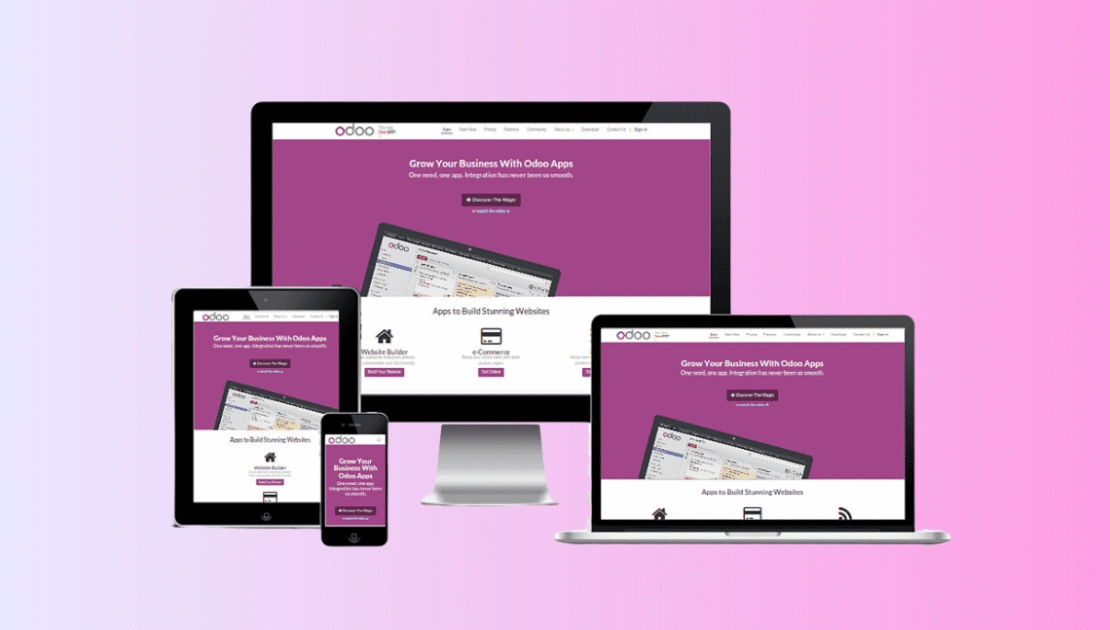Understanding Odoo as a Website Platform
Odoo transforms the perception of website development by integrating it with various business processes. It simplifies operations by allowing users to manage everything from one platform. This user-friendly approach benefits all businesses, regardless of their size.
One notable aspect of Odoo is its robust website builder. It is beneficial for both novices and seasoned developers alike. You do not need to possess advanced skills in website creation or development to utilize it. The drag-and-drop functionality allows for quick modifications. Additionally, it can be integrated with CRM tools and other applications. Odoo not only assists in constructing a website but also ensures that your website and daily business operations are aligned.
What Makes Odoo Unique for Website Creation?
Odoo stands out as it can accommodate the distinct requirements of any business. Unlike other website builder tools that solely assist in website creation, Odoo facilitates both website development and the management of various business tasks simultaneously. This allows for increased efficiency in your work. A significant advantage is its modular system, which enables you to select the Odoo modules necessary for your operations while omitting those that are not needed.
Customizing Odoo is straightforward. It provides a user-friendly drag-and-drop interface for effortlessly creating your web pages. For those with coding skills, the integrated Python tools allow you to develop personalized features. This flexibility ensures that Odoo is suitable for businesses of all sizes.
Odoo modules such as CRM, ecommerce, and product tracking tools enhance your workflow efficiency. You can gather leads, display your store online, and oversee inventory from a single platform. Odoo integrates all your diverse operations, ensuring your business operates seamlessly. It transcends a mere website builder; it is a comprehensive business system designed to adapt to your evolving requirements.
Key Features and Benefits of Odoo Websites
Odoo websites be made with strong functionalities to help businesses in many ways. Here are some key features:
- Drag-and-Drop Editor: You can make web pages with this easy tool. There is no need to know code.
- E-commerce Integration: It lets you handle your products, payment, and shipping on the same screen.
- SEO Optimization Tools: Get better visibility in search by using meta tags, sitemaps, and keyword-friendly website links.
- Multi-language Support: There is support for different languages and money types, so you can reach more people.
There is additional information. Odoo websites integrate with CRM to assist you in acquiring new customers. They also simplify business operations by overseeing inventory and provide numerous options to modify your brand’s style. There is no requirement to purchase additional plugins, resulting in cost savings. Odoo websites are easy to manage and visually appealing, all while facilitating your tasks and contributing to the growth of your business.
Preparing to Build Your Website with Odoo
Prior to initiating the creation of a website, it is essential to prepare adequately. Configuring Odoo is straightforward, and this can be accomplished on either a local server or a cloud server. This provides you with numerous options for hosting your website.
If you are a business owner, it is essential to ensure that your requirements align with the modules you select during the installation of Odoo. Familiarizing yourself with the user interface can expedite the setup process. By following these steps, creating a seamless and integrated website will be straightforward. When you feel prepared, we can discuss your needs prior to commencing.
What You Need Before Getting Started (Hosting, Odoo Installation, Basic Knowledge)
It is crucial to begin effectively before utilizing Odoo. First, select a suitable hosting service that meets your requirements. This could be either a local server or a cloud-based option. Familiarize yourself with the Odoo installation process thoroughly. Ensure that you read the documentation and adhere to each step for a seamless setup. If you possess a fundamental understanding of web development, it will greatly assist you. You will find it simpler to utilize Odoo’s website builder and engage with its advanced features. These tools will enable you to address challenges for your business more effectively.
Choosing the Right Odoo Version and Modules
Choosing the appropriate version and modules is essential for maximizing the benefits of Odoo. The Community Edition, which is open-source, is available at no cost, whereas the Enterprise Edition offers additional advanced features. It is important that the modules you select align with your business requirements—such as eCommerce, CRM, or blogging capabilities.
| Version | Pricing | Advanced Features |
|---|
| Community Edition | Free | Only the core modules are available |
| Enterprise Edition | $20+ per user per month | More advanced apps, for example, Studio and Accounting |
| Odoo.sh Hosting | Custom pricing | Offers a managed service and the ability to scale when needed |
Step-by-Step Guide: Creating Your Website with Odoo
Creating your website with Odoo can be easy and powerful at the same time. First, you need to open the website module. This is where you start to build great designs that can fit what you want.
Step 1: Setting Up the Odoo Website Module
Initiating the process is straightforward once you access the website module. Begin by logging into Odoo. Next, navigate to the Apps section. Search for ‘Website’ and proceed to install it. Upon installation, this module provides you with the necessary tools for seamless design.
Step 2: Customizing Templates, Themes, and Layouts
Personalization is easy to use with Odoo’s customization tools.
- Templates: You can pick from ready-made options for your area. Edit them to show your brand in the way you want.
- Themes: Change the colors and fonts to make your site stand out more.
- Widgets: Add sliders, forms, and other moving items by dragging and dropping them into place.
- Layouts: Update the header and footer to show your group’s details and branding just right.
Step 3: Adding Content, Menus, and Essential Pages
Organizing your content effectively can increase user engagement with your website.
Begin by creating the primary pages, which may include Home, About Us, and Contact. Odoo’s content management system (CMS) allows you to incorporate blog posts to enhance organic traffic. Additionally, you can utilize its drag-and-drop functionality to quickly construct menus.
Step 4: Optimizing for SEO, Mobile, and Performance
Ensure that your website is consistently functioning optimally.
SEO optimization tools utilize elements such as meta tags and URL structure to enhance your site’s visibility on search engines. Additionally, these tools facilitate ease of use on mobile phones and other devices, allowing users to enjoy a seamless experience regardless of how they access your site.



